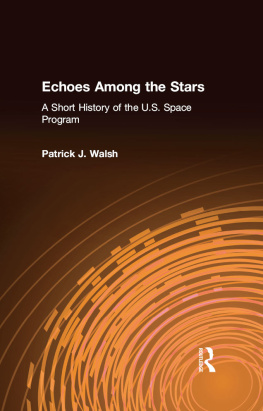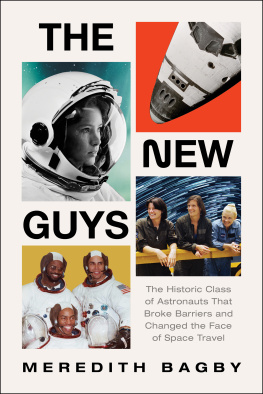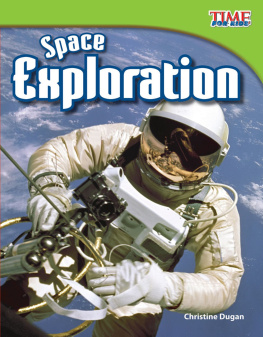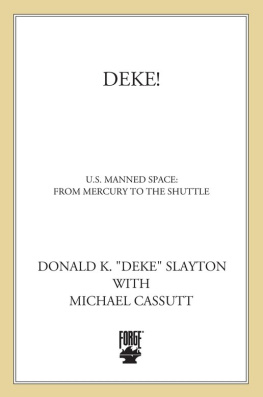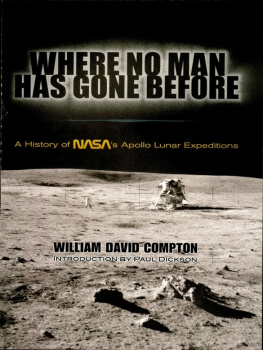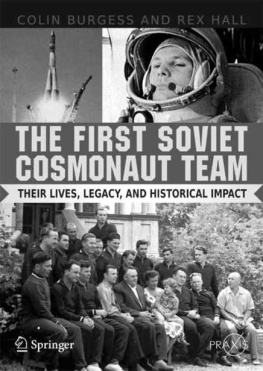echoes
among the stars
A SHORT HISTORY OF THE U.S. SPACE PROGRAM
Patrick J. Walsh
First published 2000 by M.E. Sharpe
Published 2015 by Routledge
2 Park Square, Milton Park, Abingdon, Oxon OX14 4RN
711 Third Avenue, New York, NY 10017, USA
Routledge is an imprint of the Taylor & Francis Group, an informa business
Copyright 2000 Taylor & Francis. All rights reserved.
No part of this book may be reprinted or reproduced or utilised in any form or by any electronic, mechanical, or other means, now known or hereafter invented, including photocopying and recording, or in any information storage or retrieval system, without permission in writing from the publishers.
Notices
No responsibility is assumed by the publisher for any injury and/or damage to persons or property as a matter of products liability, negligence or otherwise, or from any use of operation of any methods, products, instructions or ideas contained in the material herein.
Practitioners and researchers must always rely on their own experience and knowledge in evaluating and using any information, methods, compounds, or experiments described herein. In using such information or methods they should be mindful of their own safety and the safety of others, including parties for whom they have a professional responsibility.
Product or corporate names may be trademarks or registered trademarks, and are used only for identification and explanation without intent to infringe.
Library of Congress Cataloging-in-Publication Data
Walsh, Patrick J., 1963
Echoes among the stars : a short history of the U.S. space program / Patrick J. Walsh.
p.cm.
Includes bibliographical references and index.
ISBN 0-7656-0537-6 (alk. paper)
ISBN 0-7656-0538-4 (pbk. alk paper)
1. AstronauticsUnited StatesHistory. I. Title
TL789.8.U5W3 2000
629.40973dc21
99-38899
CIP
ISBN 13: 9780765605382 (pbk)
ISBN 13: 9780765605375 (hbk)
I dedicate this work to my parents, whose faith has never wavered.
Table of Contents
This work could not have been imagined, let alone completed, without enormous amounts of inspiration, support, and love. For all their help over a very long period of time, I would like to acknowledge the encouragement of my parents, John E. and Helen E. Walsh, my brother, Michael, my sister-in-law, Eneida, and my niece and nephews, Kelliann, Michael, and James. My aunt, Sister Margaret Walsh, must also be singled out for the special support she has given this project. Anyone who has felt the warmth of a supportive family will surely understand my enduring gratitude for those who are closest to my life and work.
I have also had the good fortune of easy access to a number of close business associates and friends who are always receptive to discussions about my ideas and the progress of my research and writing. For the remarkably open and productive environment these special people have helped to create for me over the past decade, I offer heartfelt thanks to Alex Mendelsohn, a superb editor and loyal friend, and to Steven Borzoni and Margie Burns, for their generous professional and personal support of this project in particular, and of my career in general.
In addition, I would also like to thank all those who read various portions of my space book manuscript in various stages of its progress and who lent their enthusiasm to the work and its author. Suze Albright Lewitt, Dave Lewitt, Lennox Holness, Marshall and Cecilia Woodall, and Jen Brennan have been particularly kind in this respect.
There have also been a large number of academic supporters and friends who have encouraged my research and writing, foremost among them Dr. Lawson Bowling, Sister Ruth Dowd, Dr. Ruth Eisenberg, Professor John S. Joy, Professor Robert Klaeger, Dr. Howard Livingston, Dr. Charles Masiello, and Dr. Donald Ryan.
Finally, I wish to acknowledge all those who have believed in this project, inquiring about its progress and direction and offering encouragement along the way. Many of these supporters have been my students at Pace University; the love for the future expressed by them and their counterparts at colleges and high schools across the country was a renewing inspiration throughout the process of completing this project.
The story of how humanity first managed to break free of its cradle, earth, and venture into the vastness of space begins, appropriately enough, with an international conference. Convened in Rome in October of 1954 to plan the International Geophysical Year of 19571958, the gathering of scientists from forty different countries resulted in a far-ranging plan of experiments and exploration in disciplines as varied as physics, geology, meteorology, and aerospace. Of all the ambitious objectives the participants sought to undertake, the most novel was the plan to launch a small satellite into earth orbit.
A modest goal by modern standards, the plan to send a basketball-sized probe containing few (if any) scientific instruments into orbit around the earth seemed a fantastic notion to the average American when it was formally introduced in July 1955. As a result of the Rome conference and in cooperation with other countries, the U.S. government announced its intent to play the leading role in the satellite launch.
Following a familiar pattern, the government of the Soviet Union also announced a plan to send a satellite into orbit during the International Geophysical Year.
The American move was both strategic and tactical, and its aims were political as well as scientific. Far beyond the obvious benefits to space science that would result from the development of the equipment, systems, and procedures necessary to create and launch the satellite, the U.S. effort was also calculated as a means to outpace the USSRs increasingly optimistic pronouncements about the progress of its own space plans. Thus the seeds of the space race, as it would become known in earnest within the next decade, were sown in the mid-1950s.
Spoils of War, Visions of Space
For both the United States and the USSR, the first fruits of the Allied victory in World War II included a generous portion of German rocket technology, as well as many of the scientists and technicians who had developed it. Of particular interest to both sides was the German V-2 rocket; many of the Soviets earliest steps toward space were based on further development of the basic V-2, and the United States began firing captured V-2s as well as American-made counterparts in White Sands, New Mexico, in 1946.
The Soviets incorporated many German technicians into their rocket development efforts immediately after the war, gaining the benefit of their expertise and then gradually allowing them to return to Germany in the early 1950s. But, fearing Soviet retribution for Hitlers savage Russian campaigns, a large majority of the most sought-after German scientists surrendered to the Western Allies at the end of the war. As a result, the United States received the lions share of V-2 rocket expertise, including the skills of pioneering space scientists Hermann Oberth and Wernher von Braun.
Given the political and social climate of the day, with the former allies sliding precariously into the first decade of the nuclear age and the initial years of the cold war, it seems inevitableand in many ways beneficialthat the United States and USSR would embark on a decade-long competition to send first satellites, then human beings, into orbit and eventually to the moon. The two nations race to develop their space programs coincided with the initial stage of their harrowing development of vast stockpiles of nuclear weapons. Locked into an arms race that by its nature provided no hope of victory but at the same time gave neither side any practical way to withdraw, America and the Soviet Union feverishly pursued the benefits of propaganda and prestige that early hegemony in space could provide.

